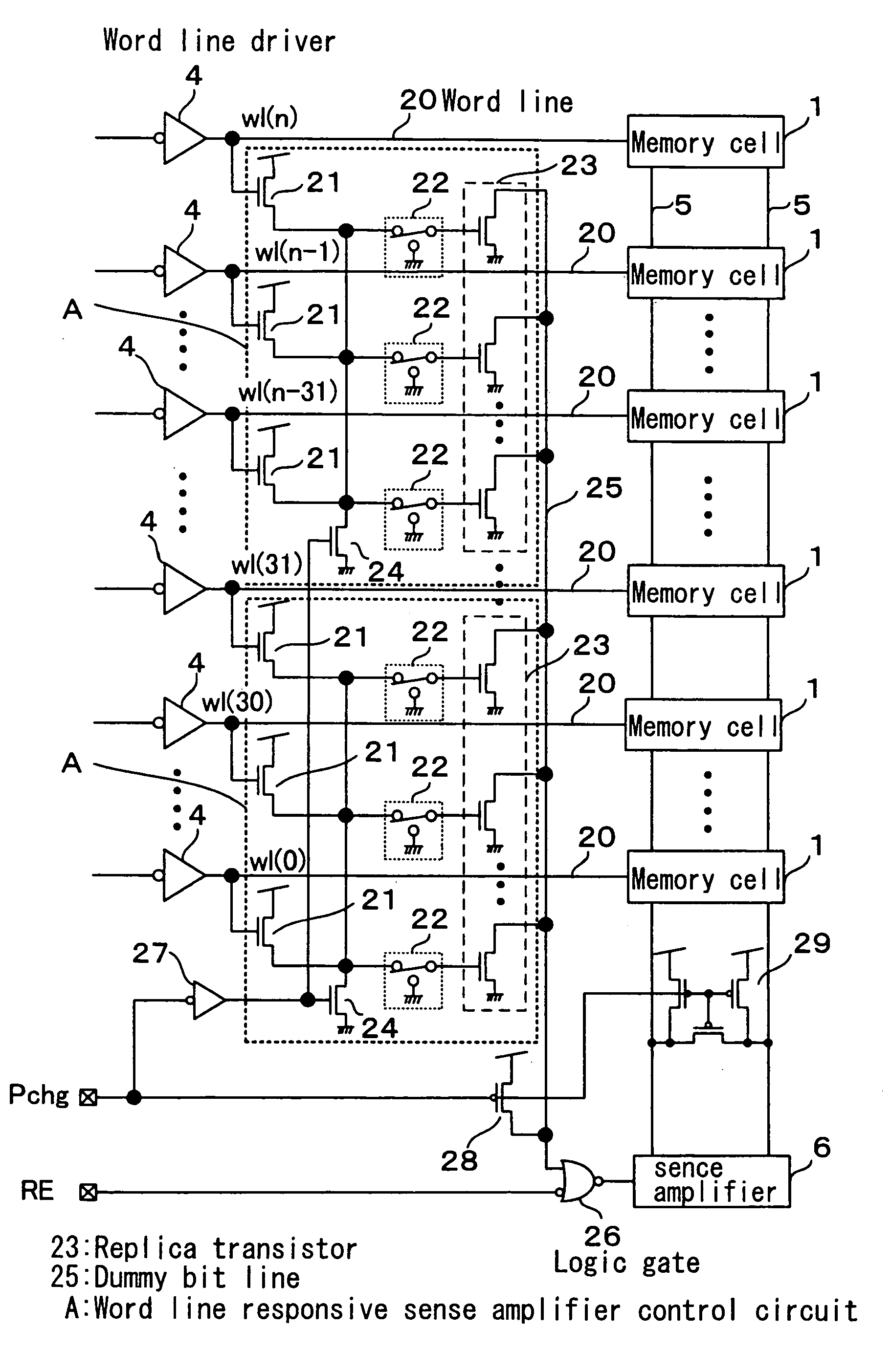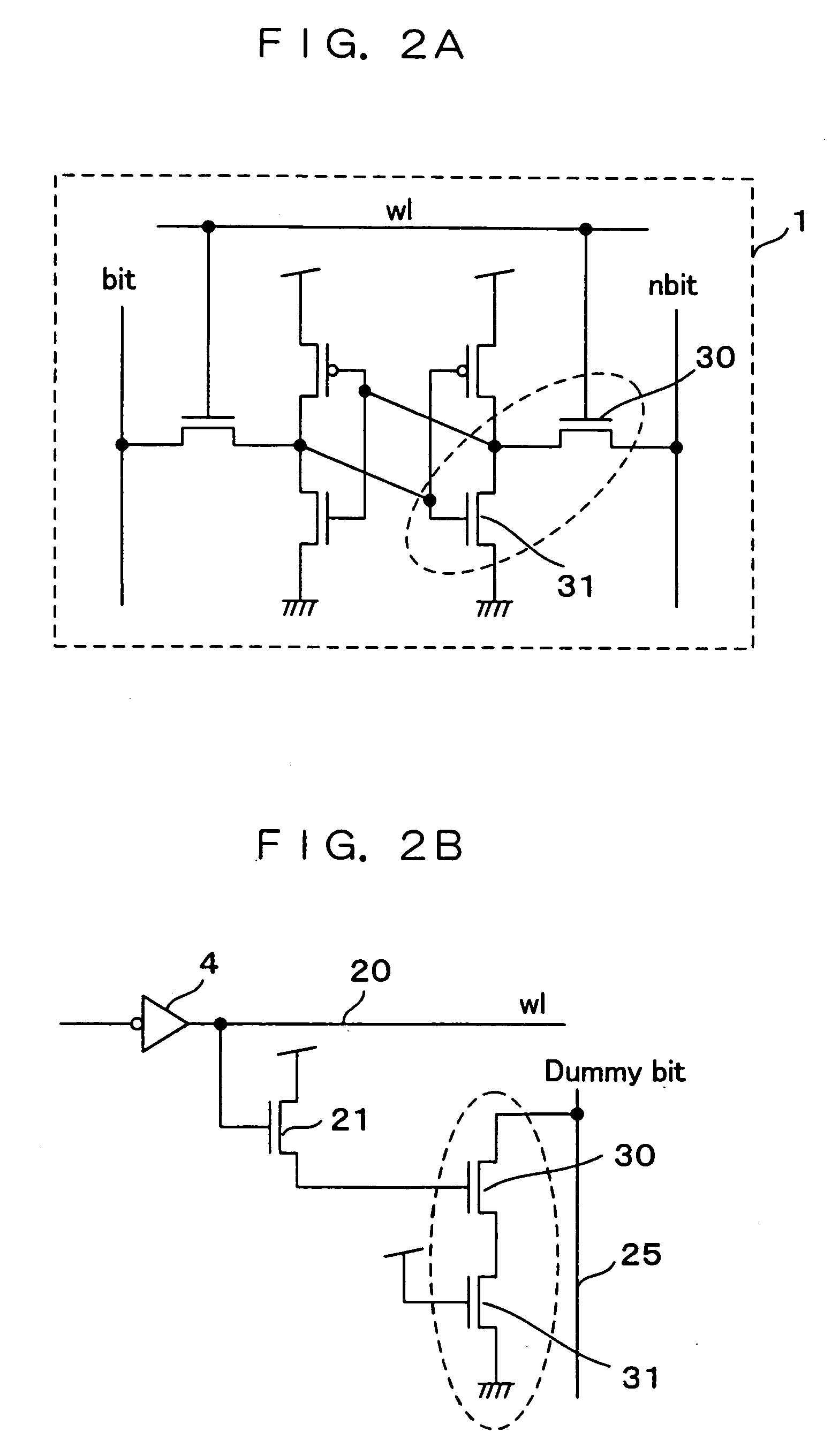Semiconductor memory storage device capable of high operating speed
- Summary
- Abstract
- Description
- Claims
- Application Information
AI Technical Summary
Benefits of technology
Problems solved by technology
Method used
Image
Examples
first embodiment
[0049]FIG. 1 is a schematic circuit diagram of a static random-access memory (hereinafter referred to as SRAM) as a semiconductor memory storage according to a first embodiment of the invention. In FIG. 1, the same component parts as the corresponding ones in FIG. 5 showing a conventional semiconductor memory storage are designated by the same reference numerals, respectively and not described again. In FIG. 1, each of a plurality of word lines 20 connected to the corresponding one of a plurality of word drivers 4 and the corresponding one of a plurality of memory cells 1 branches and is connected to the gate of the corresponding one of a plurality of n-channel field-effect transistors (hereinafter referred to as the n-ch transistors) 21 as a word line responsive switching element. The drain of the n-ch transistor 21 is connected to the high potential side of a power supply, and the source thereof is connected through a selective switching element 22 to the gate of a replica n-chann...
second embodiment
[0056]FIG. 2A is a schematic circuit diagram of a SRAM as a semiconductor memory storage according to a second embodiment of the invention. In FIG. 2A, the same component parts as the corresponding ones of the prior art shown in FIG. 5 and the embodiment shown in FIG. 1 are designated by the same reference numerals, respectively, and not described again. In FIG. 2, the replica transistor 23 shown in FIG. 1 is arranged as a dummy cell for optical correction. The dummy cell for optical correction is arranged in order to suppress the variations of the characteristics of the memory cells.
[0057]The pass transistor 30 and the drive transistor 31 shown in FIG. 2A are used as dummy transistors for optical correction. The replica transistor 23 in FIG. 1 is configured of a pass transistor 30 shown in FIG. 2B and a drive transistor 31 with the gate thereof fixed to the high potential side of the power supply in saturated form.
[0058]The operation of the semiconductor memory storage according to...
third embodiment
[0060]FIG. 3 is a schematic circuit diagram of a SRAM as a semiconductor memory storage according to a third embodiment of the invention. In FIG. 3, the same component parts as the corresponding ones of the prior art shown in FIG. 5 and the embodiment shown in FIG. 1 are designated by the same reference numerals, respectively, and therefore not described again. In FIG. 3, a logically inverting gate (inverter) 40 is connected to the branch line from each word line 20 on the output side of each word line driver 4, and the output of the logically inverting gate 40 is connected to the gate of a p-channel field-effect transistor (hereinafter referred to as the p-ch transistor) 41 as a work line responsive switching element. The source of the p-ch transistor 41 is connected to the high potential side of the power supply. The drain of the p-ch transistor 41 is connected to the gate of the replica transistor 23. The drain of each p-ch transistor 41, on the other hand, is connected to the ga...
PUM
 Login to View More
Login to View More Abstract
Description
Claims
Application Information
 Login to View More
Login to View More - R&D
- Intellectual Property
- Life Sciences
- Materials
- Tech Scout
- Unparalleled Data Quality
- Higher Quality Content
- 60% Fewer Hallucinations
Browse by: Latest US Patents, China's latest patents, Technical Efficacy Thesaurus, Application Domain, Technology Topic, Popular Technical Reports.
© 2025 PatSnap. All rights reserved.Legal|Privacy policy|Modern Slavery Act Transparency Statement|Sitemap|About US| Contact US: help@patsnap.com



